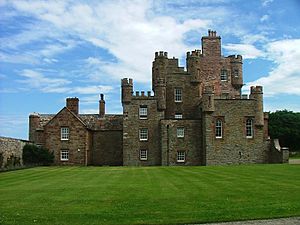Castle of Mey facts for kids
Quick facts for kids Castle of Mey |
|
|---|---|

The Castle of Mey in 2014
|
|
| Former names | Barrogill Castle |
| General information | |
| Country | Scotland |
| Coordinates | 58°38′49″N 3°13′29″W / 58.64708°N 3.22479°W |
| Construction started | 1566 |
| Completed | 1572 |
| Renovated | 1950s |
| Owner | Castle of Mey Trust |
The Castle of Mey is a historic castle on the north coast of Caithness, Scotland. It is located about six miles west of the famous village of John o' Groats. On a clear day, you can see the beautiful Orkney Islands from the castle. For a while, it was also known as Barrogill Castle.
The castle is most famous for being the beloved holiday home of Queen Elizabeth The Queen Mother, the mother of Queen Elizabeth II. Today, it is cared for by a special trust and is open for visitors to explore.
Contents
History of the Castle
Who Built the Castle of Mey?
The Castle of Mey was built between 1566 and 1572. It was constructed for George Sinclair, the 4th Earl of Caithness. An earl is a high-ranking nobleman in Britain. The castle was built on land that once belonged to the Bishops of Caithness.
The original castle was a three-story building designed in a "Z" shape. This meant it had a main rectangular block with towers at opposite corners, which was a smart way to defend the castle from all angles.
Changes Over the Centuries
After the 4th Earl died, the castle was passed down through the Sinclair family. For a long time, its name was changed to Barrogill Castle. Over the 17th and 18th centuries, the castle was expanded and changed. In 1821, it was updated in a style called Tudor Gothic, which made it look even more grand and historic.
The Sinclair family owned the castle until 1889. After that, it had a few different owners. During the Second World War, it was used as a place for army officers to rest. By 1950, the castle had fallen into disrepair, and only its main tower was still in a livable condition.
A Royal Holiday Home
In 1952, the castle was in a very poor state. That year, it was bought by Queen Elizabeth The Queen Mother. Her husband, King George VI, had recently passed away, and she was looking for a peaceful retreat.
The Queen Mother decided to save the castle. She began a major restoration project to bring it back to life. She removed some of the changes that had been made in the 1800s and changed its name back to the Castle of Mey. For the first time in its long history, the castle was given electricity and running water.
From 1955 until she passed away in 2002, the Queen Mother would visit the castle every year in August and October. It was her private home where she could relax, enjoy the gardens, and look out at the sea. Her last visit was in October 2001.
The Castle of Mey Trust
Protecting the Castle's Future
In 1996, the Queen Mother created the Queen Elizabeth Castle of Mey Trust. A trust is an organization set up to care for a special place. She gave the castle, its gardens, and the farm to this trust to make sure it would be protected forever.
The trust's main goals are:
- To preserve the historic castle and its contents.
- To teach people about its history and architecture.
- To raise special breeds of Aberdeen Angus cattle and Cheviot sheep on the farm.
- To support projects that help the local community.
Since the Queen Mother's death, the trust has opened the castle and gardens to the public. This helps raise the money needed to maintain the estate.
New Leadership and Projects
On January 1, 2019, the Prince's Foundation took over the management of the trust. The foundation is run by King Charles III, who is the Queen Mother's grandson. He continues to support his grandmother's vision for the castle.
The trust has completed important work, such as repairing the roof and rewiring the castle to keep it safe.
The Granary Lodge
In 2019, a new 10-bedroom bed and breakfast called the Granary Lodge was opened on the castle grounds. It was created by converting the old stables and granary. The money earned from guests staying at the lodge helps pay for the upkeep of the castle.
Today, the castle is open to visitors from May to September. However, it closes for a short time in late July and early August when King Charles III and Queen Camilla come to stay, continuing the royal family's tradition.
See also
 In Spanish: Castillo de Mey para niños
In Spanish: Castillo de Mey para niños


